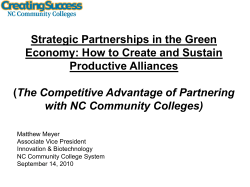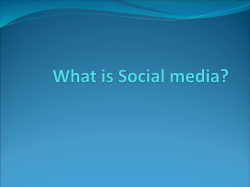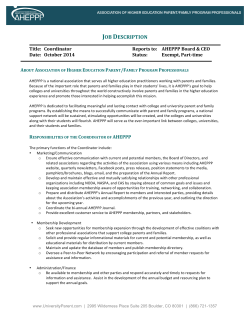
1 Written Testimony Kati Haycock, President, The Education Trust
Written Testimony Kati Haycock, President, The Education Trust before the United States Commission on Civil Rights 28 May 2015 Members of the Commission. Thank you for the opportunity to testify before you today on the important subject of the role of higher education in opportunity in America. In my few minutes with you, I want to talk with you about the national context, about what we know about access and success in higher education — and for whom, and about some of the reasons behind these patterns. As Americans, we tell each other and the world two important stories about who we are as a country. The first is that we are the “land of opportunity.” Whether your parents were born in a village in India or in the hollers of Western Kentucky, we are the place — above all others — where, if you work hard, you can become anything you want to be. The second story is one of constant, intergenerational advancement. That each generation of American parents, through hard work and savings, can assure its children a better education and a better life. Those stories, as you know, are very powerful. And they are pervasive in how we think about ourselves as a nation. But they are fast slipping away. Since the 1980s, income inequality has been growing. Earnings among those at the top of the economic ladder have grown exponentially, while earnings among those at the bottom of the ladder have fallen backward. Now, instead of being among the most equal nations on earth we are one of the most unequal, with income inequality third highest in the developed world. There are significant differences in family wealth, as well, with the median wealth among white families now 20 times that among black families and 18 times that among Latino families. At the same time, there are growing problems with social mobility. All of you know, of course, that there have always been some Americans for whom opportunities weren’t equal. But, over time, we were getting better at that. Unfortunately, in the ’80s, things started going in the other direction again. If you are born poor today, it is harder than at any time since the 1920s to work your way up the economic ladder. Indeed, rather than being the “land of opportunity,” the U.S. is now tied with the United Kingdom and Italy for being the developed countries where those born into poverty are least likely to escape it as adults. Ironically, children born poor in Canada today are more likely to be able to live the American Dream than those born poor here in the USA. At the macro level, of course, better and more equal education is not the only thing that needs to change in order to turn these patterns around and head our country back toward the principles we hold dear. There are a lot of important things that enlightened public policy could and should do. 1 At the individual level, though, quality education literally is the only way up. As generations on generations of African American parents have taught their children, “A good education is the only thing that nobody can ever take away from you.” Today, with only a high school diploma, just under half of the children born poor in America today will remain poor as adults. And even more will remain under the average. With a college degree, however, those numbers plummet to 1 in 6. And for African American males the consequences of education are even starker. Among those who don’t complete high school, 68% will be imprisoned by age 34. With a high school diploma, that rate falls to 21%; with a college degree, to 6%. College graduates earn more. They are less likely to be unemployed. But they also stand out in other things we value. They are more likely to vote, to volunteer, to have healthy life practices, and even to have better mental health. What our schools and colleges do, in other words, is hugely important to our economy, to our democracy, and to our society more generally. So, how are we doing? Over the past 30 years, we’ve made a lot of progress on the access side. Virtually every year, the number of high school graduates going directly on to college has gone up. And those increases have occurred across economic and racial groups. For all, college-going has gone steadily upward. It is important to note, however, that — though college-going has gone up for lowincome students, they still don’t enter college at the same rate as did high-income students in the early 1970s. There is also, of course, a question of access to what. Here, the differences are clear: Low-income students and students of color who enter college are more likely to begin in two-year colleges or forprofit institutions, from which they are least likely to graduate — and, in the case of the for-profits, are most likely to end up with significant debt. What about graduation more generally? In both four-year and two-year institutions, students of color are less likely to graduate than their peers. And when you ask the question, “What about students who aspire to a bachelor’s degree, but begin in a two-year college: What are their chances?” Only 14%. Add these numbers up and you end up with very different degree acquisition rates. For every 100 white children we start with in this country, roughly 90 end up with a high school diploma or a GED; of them, roughly 40 end up with at least a bachelor’s degree. Among black children, the bachelor’s degree rate is just over one-half the white rate; among Latinos only roughly one-third. And the data by family income are even more disparate: Students in the top income quintile are now seven times as likely as those in the bottom quintile to earn a degree by age 24. 2 What’s going on here? There are a lot of people in higher education who believe that these patterns are largely a result of two things: lousy high schools and stingy policymakers. Those who believe this aren’t all wrong. Even today, low-income students and students of color continue to be clustered in schools where we spend less on their education, expect less from them, teach them less, and assign them our least experienced, least well-educated and least effective teachers. While we are making some progress in turning these patterns around in our elementary schools, we have not yet turned the corner in our high schools, where the gaps separating students of color from their peers are about as large today as they were in 1990. So yes, lousy preparation is part of the problem. So, too, are stingy policymakers. As you all know, the costs of attending college have gone up astronomically in recent years. And the Pell Grant, the most important vehicle to allow low-income students to afford college, just hasn’t kept pace. That grant used to cover roughly 75% of the cost of attending a four-year college, but today covers less than one-third. What’s important to understand, though, is that this is not because the government isn’t spending a lot more money on financial aid: It is. What has changed is who those dollars are being spent on, with billions of dollars in tax credits and tax deductions going not to the families who need support the most, but to those much higher on the income spectrum. And the same is true of state financial aid, increasing portions of which are going not to need-based aid, but to something else. So yes, poor government decision-making is part of the problem, too. But, when you look honestly at the facts, it quickly becomes apparent that colleges themselves — through the choices they make — are not unimportant players in this drama of shrinking opportunity in America. For starters, colleges and universities have their own financial aid dollars, called institutional aid, over which they have total control. And yet, when you look at whom those dollars are spent on, it turns out that the shift here from low-income students to students at the top of the income ladder has been even more pronounced than the shifts in federal and state aid. In 2011, four-year colleges and universities spent a combined $21 billion in financial aid for their students. But they spent a lot of it on students who had no financial need whatsoever. Back in 1995, for example, public colleges and universities spent more than twice as much on students in the lowest income quintile than they did on students in the highest quintile. But today, they actually spend more on those in the top quintile! The patterns among nonprofit private universities are even worse: They, too, used to spend more on students in the bottom quintile, but today spend more than 50% more on students in the top quintile. 3 The results are devastating: After financial aid from all sources is taken into account, the average student in a low-income family must come up each year with an amount equivalent to 72% of his family’s totally household income. This burden is far higher than on families in any other income category. So yes, colleges themselves — through the choices they make — have a significant impact in deciding who comes and who doesn’t. It turns out that colleges also have a significant impact on who graduates and who doesn’t. When you look at the data nationally, our overall success problems quickly become clear. Among students who start full time in four-year colleges, fewer than 4 in 10 end up with a four-year degree in four years. When you extend the range to six years, the numbers climb to around 6 in 10. And when you look not just at the initial institution, but at whether a student graduated from any institution, the success rate climbs to about two-thirds. That, however, is the average. Underneath that, institutions are all over the map. Some, year in and year out, manage to graduate upward of 80, 85, even 90% of their students within six years. Others consistently get fewer than 15%, and some fewer than 10%, of their students through with a degree in the same time span. Of course, some of this is about institutional selectivity and mission. In general, the colleges with high success rates tend to be highly selective, admitting only well-prepared students, pitifully few of whom are poor or of color. On the other end, the low success rate institutions tend to be open access institutions, serving many ill-prepared students, many of whom are poor. Indeed, with enough data, you can “explain” more than 75% of the variance in graduation rates. Sadly, that statistic has led many within higher education to believe that, short of admitting better prepared students, there is nothing they can do to change the success patterns on their campuses. But this “demography as destiny” notion turns out not to be true. For all across the country, there are institutions that are far more successful than other institutions that serve exactly the same kinds of students. (You can see this phenomenon quite clearly if you spend a few minutes looking at our College Results Online tool, which compares disaggregated graduation rates at every college in America with the 15 to 25 colleges most like it.) Penn State University, Purdue, the University of Minnesota, and Indiana University have much in common. They are large, highly selective institutions that largely serve well-prepared students. Few of their students are poor or of color. They have similar missions. Yet their success rates are actually quite different, ranging from Penn State, which consistently gets in the high 80s of its students through with a degree in six years, to Purdue, which gets only 68% of its students through in the same period. And the numbers for underrepresented minorities are even more different, from a graduation rate of 78% at Penn State to 44% at the University of Minnesota. Similar institutions, but very different results. The same is true among historically black colleges. Elizabeth City State, Delaware State, Norfolk State, University of Arkansas Pine Bluff, and Coppin State have much in common. Most of their students are 4 poorly prepared. Most are poor. But though their missions are very much the same, their success rates vary from the high 40s at Elizabeth City to under 15% at Coppin. Similar institutions, different results. Around the country, some institutions are consistently doing a better job at graduating their students — both in general and for underrepresented students — than others that serve essentially the same kinds of students. Too, in recent years, some institutions have made whopping gains in success rates for their URM students and have significantly narrowed — if not eliminated entirely — the gaps in graduation rates among different kinds of students. Once again, it seems very clear that colleges themselves, through the choices they make, play a hugely important role in determining who graduates and who doesn’t. So yes, we have to keep working on improving our high schools. And yes, federal and state policymakers need to step up to their responsibilities. But if we are to successfully turn around patterns of opportunity in this country, we also need to work on changing the way our colleges do business, as well. Thank you. Attachment: Slide Deck 5
© Copyright 2025

















